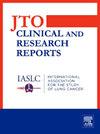Durvalumab With or Without Tremelimumab in Combination With Chemoradiotherapy in Patients With Limited-Stage SCLC: Results from the Phase 1 CLOVER Study
IF 3.5
Q2 ONCOLOGY
引用次数: 0
Abstract
Introduction
The phase 1 CLOVER study (NCT03509012) evaluated durvalumab with or without tremelimumab in combination with concurrent chemoradiotherapy (cCRT) in patients with advanced solid tumors; here, we report findings from the limited-stage SCLC (LS-SCLC) cohort.
Methods
Patients with pathologically confirmed LS-SCLC whose disease could be encompassed within a radical radiation portal received durvalumab (arms 1 and 2) or durvalumab plus tremelimumab (arms 3 and 4) in combination with cCRT (cisplatin-etoposide and either standard radiotherapy [arms 1 and 3] or hyperfractionated radiotherapy [arms 2 and 4]). The primary end point was safety and tolerability. Preliminary efficacy and candidate biomarkers of response were assessed.
Results
Overall, 33 patients were enrolled: 12 in arm 1, 12 in arm 2, six in arm 3, and three in arm 4. No patients had dose-limiting toxicity. Grade 3 or 4 adverse events occurred in 79.2% of patients from arms 1 and 2 and 88.9% from arms 3 and 4; the most common were hematologic events. In arms 1, 2, 3, and 4, objective response rate was 66.7%, 66.7%, 83.3%, and 100.0%, disease control rate was 90.9%, 100.0%, 100.0%, and 100.0% at 18 weeks and 72.7%, 83.3%, 100.0%, and 100.0% at 48 weeks, and the median progression-free survival (PFS) (95% confidence interval) was 9.2 months (5.3‒not estimable [NE]), 16.6 months (8.4–NE), not reached (16.6–NE), and 9.3 months (6.3–NE), respectively. In exploratory biomarker analyses, no difference in PFS by programmed cell death-ligand 1 expression level was observed; median PFS was numerically greater in high versus low tumor inflammation signature and CD8A expression subgroups.
Conclusions
Durvalumab in combination with cCRT, with or without tremelimumab, was tolerable and active in patients with LS-SCLC.
Durvalumab联合或不联合Tremelimumab联合放化疗治疗有限期SCLC患者:来自1期CLOVER研究的结果
1期CLOVER研究(NCT03509012)评估了durvalumab联合或不联合tremelimumab联合同步放化疗(cCRT)治疗晚期实体瘤患者;在这里,我们报告了来自有限期SCLC (LS-SCLC)队列的研究结果。方法病理证实的LS-SCLC患者接受durvalumab(第1组和第2组)或durvalumab + tremelimumab(第3组和第4组)联合cCRT(顺铂- etopo苷加标准放疗[第1组和第3组]或超分割放疗[第2组和第4组])治疗。主要终点是安全性和耐受性。评估初步疗效和候选生物标志物。结果共纳入33例患者:1组12例,2组12例,3组6例,4组3例。没有患者出现剂量限制性毒性。3级或4级不良事件发生在第1组和第2组的79.2%和第3组和第4组的88.9%;最常见的是血液学事件。在1、2、3和4组中,客观缓解率分别为66.7%、66.7%、83.3%和100.0%,18周时疾病控制率分别为90.9%、100.0%、100.0%和100.0%,48周时疾病控制率分别为72.7%、83.3%、100.0%和100.0%,中位无进展生存期(PFS)(95%置信区间)分别为9.2个月(5.3 -不可估计[NE])、16.6个月(8.4-NE)、未达到(16.6 - NE)和9.3个月(6.3-NE)。在探索性生物标志物分析中,程序性细胞死亡配体1表达水平与PFS无差异;肿瘤炎症特征和CD8A表达高亚组与低亚组的中位PFS数值更高。结论durvalumab联合cCRT,无论是否联合tremelimumab,在LS-SCLC患者中是可耐受的和有效的。
本文章由计算机程序翻译,如有差异,请以英文原文为准。
求助全文
约1分钟内获得全文
求助全文
来源期刊

JTO Clinical and Research Reports
Medicine-Oncology
CiteScore
4.20
自引率
0.00%
发文量
145
审稿时长
19 weeks
 求助内容:
求助内容: 应助结果提醒方式:
应助结果提醒方式:


